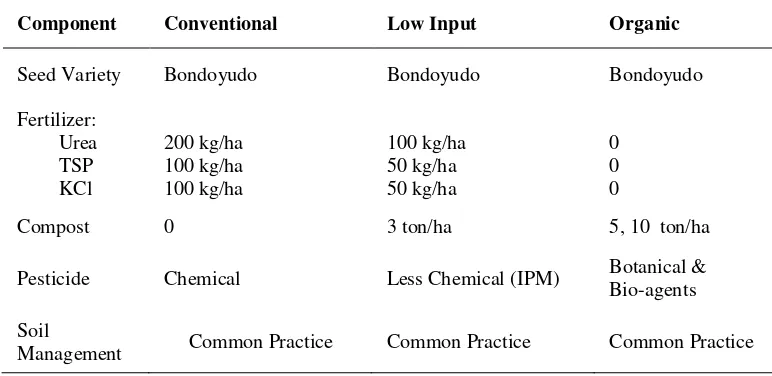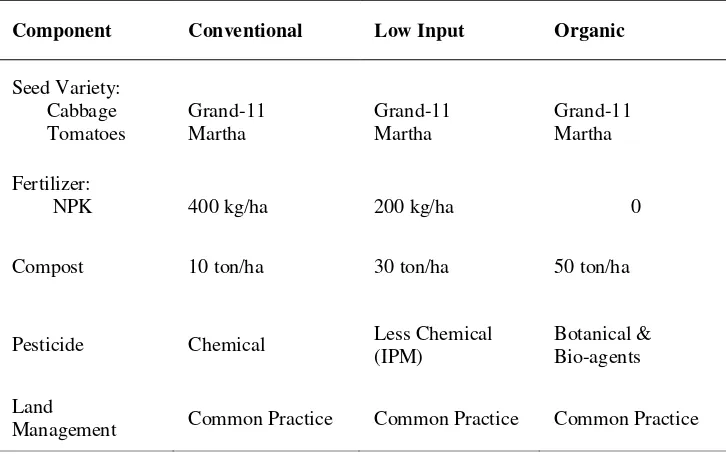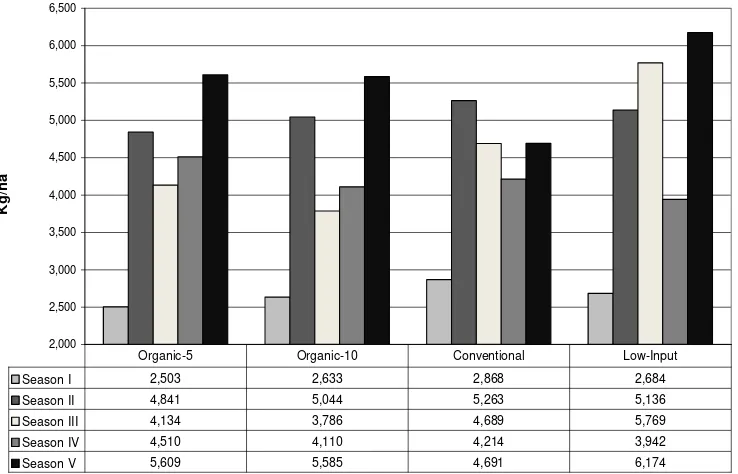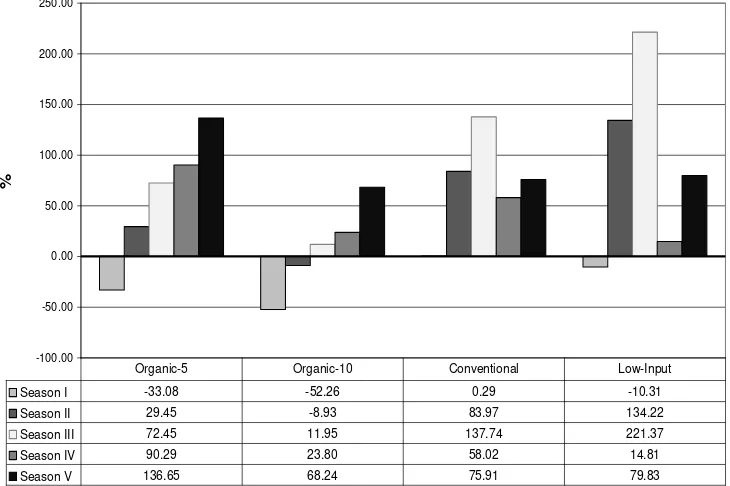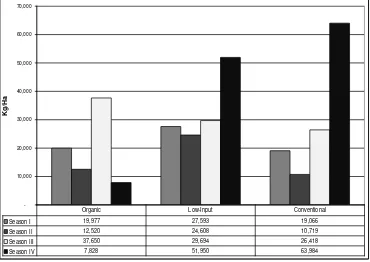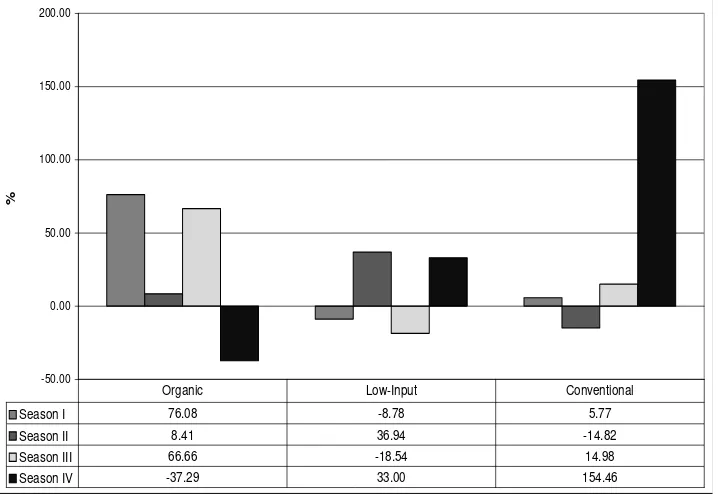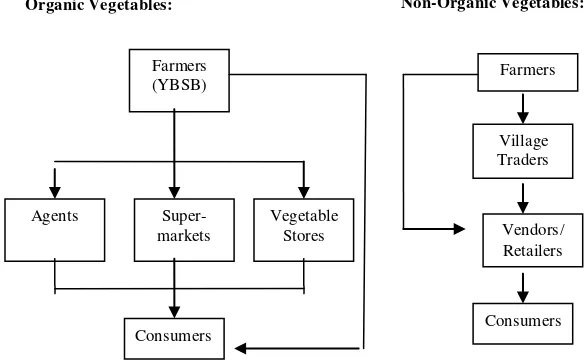49
SOCIO-ECONOMIC ASSESSMENT OF ORGANIC FARMING IN BOGOR, WEST JAVA, INDONESIA
Yusman Syaukat
Department of Resource and Environmental Economics
Faculty of Economics and Management, Bogor Agricultural University (IPB) Bogor, Indonesia
(Received: January 22, 2008; Accepted: November 22, 2008)
ABSTRACT
Adoption and implementation of Green Revolution Technology, the so called Conventional Agriculture (CA), has increased agricultural production. However, the application of chemical fertilizers & pesticides under CA has resulted in some problems: falling biodiversity, soil degradation, soil & water pollution, and human health problems. In response to these problems, some people demand safer foods which are produced under Organic Agriculture (OA).
Demand for organic products – particularly rice and vegetables - steadily increases in some big cities of Indonesia, especially in Java. The demand for these products is quite small compared to total demand of the conventional products. Due to small demand and under-developed market for organic products, the farmers are reluctant to produce the organic products. Could Organic Agriculture (OA) produce comparable or even higher yields and incomes? Would OA empower the farmers, reduce rural poverty, and improve their livelihood?
Field research in Bogor indicated that organic rice yield steadily increased with planting season and approaching that of conventional one. But, this trend was not applicable for organic vegetables. Organic vegetable yield was still lower than that of conventional one and very sensitive with the weather conditions, pests and diseases. From economic point of view, organic rice was economically feasible. It resulted in higher incomes, due to higher prices, than those of conventional ones. However, organic vegetable was still infeasible. Market for organic products was also very specific. This has made the farmers reluctant to adopt organic agricultural system. Some programs are suggested in developing the organic farming system in the region: expansion of the organic products markets through the development of market networks and farmers‟ cooperation; and improvement of government supports for agricultural development, including technical training on organic farming and provision of extension workers.
Key words: conversion to organic farming, farm yield and income, marketing system
INTRODUCTION
with land development and irrigation rehabilitation, and crop intensification programs, Indonesia achieved rice self-sufficiency in 1984. Due to rapid rate of fertile agricultural land conversion to non-agricultural use (at an average rate of 50,000 ha/year), climate changes (prolonged drought and flood periods), environmental degradation, reduced subsidies of agro-inputs and agricultural extension activities, Indonesia rice self-sufficiency began unstable. Since 1994, Indonesia started to import rice whether to meet the demand or to maintain a national buffer stock for market operation in case of rice scarcity. However, due to continuous efforts in increasing food production, currently Indonesia could reach almost 100% of its rice requirements. Import level is significantly low (less than 2% of total national rice production in 2006) compared to the previous levels. Total harvested area of paddy in 2006 was 11.84 million ha and produced 54.55 tons of paddy rice (BPS, 2007).
Production of vegetable crops in Indonesia increased at 5.65% per annum in the period of 2000-2004. In 2004, total vegetable production was estimated at 9.06 million tons. Statistically, there are six important vegetables in Indonesia, in terms of their total production: shallot, spring onion, potato, cabbage, mustard green, and carrot (BPS, 2007). Production of organic vegetables is still very small, less than 1%, and its demand is limited at certain big cities in Indonesia.
However, the steadily increase in rice and vegetable production in Indonesia under the conventional farming system, in fact, have resulted in negative side effects, including the presence of chemical residues on foods, and destruction of land fertility and productivity due to long-term chemical fertilizers and pesticides applications. These conditions have been raising environmental problems and, up to some point, human health problems.
In developed countries, consumers‟ and farmers‟ demands for environmentally friendly and healthy foods have created the organic agricultural movement (Scialabba, 2000a). Lampkin (1994) defined organic agriculture as an approach to agriculture where the aim is to create integrated, humane, environmentally, and economically sustainable agricultural production systems, which maximize reliance on farm-derive renewable resources and the management of ecological and biological processes and interactions, so as to provide acceptable levels of crop, livestock and human nutrition, protection from pests and diseases, and an appropriate return to the human and other resources employed. Similarly, Organic Farming Research Foundation (2001) defined organic agriculture as an ecological production management system that promotes and enhances biodiversity, biological cycles, and soil biological activity. It is based on minimal use of off-farm inputs and on management practices that restore, maintain and enhance ecological harmony. The primary goal of organic agriculture is to optimize the health and productivity of interdependent communities of soil life, plants, animals and people. Organic farming system is sometimes understood as a farming system that does not use toxic chemical pesticides or fertilizer to produce fiber and food. Instead, it is based on the development of biological diversity and the maintenance and replenishment of soil fertility. Prevention is the key strategy of organic farmers in controlling pests and diseases.
51
primary goal of OA is to optimize the health and productivity of interdependent communities of soil life, plants, animals, and people.
Organic agriculture activities in Indonesia were started in 1970s. OA was experiencing a slow growth. In terms of land area, OA occupies about 0.09% of total arable land in 2000. Three phases can be distinguished (Fatoni, cited by Syariefa 2004) in the development of OA in Indonesia. First, the 1970s pioneer phase i.e., people who believe in the concept of organic farming as a natural balance philosophy, with the likes of Elsener Agatho, the founder of Yayasan Bina Sarana Bhakti. Second, the 1980s phase, characterized by the rise of non government organization (NGO) movements which developed OA with foreign aid, particularly from FAO. The most popular program in this phase is Integrated Pest Management (IPM). Third, the 2000s hobbyist farmers. These farmers turn into OA because they see business opportunities.
The Indonesian Ministry of Agriculture in 2000 had declared “Indonesia Organic 2010”. The mission of this policy was to realize the eco-agribusiness development, while its objective was to increase food security and social welfare (Budianta 2004).
Problem Statement
Consumers‟ demands for environmental quality and healthy agricultural products have resulted in growing demands of organic products. Scialabba (2000a) argued that, in both developed and developing countries, organic agriculture has grown outside public support, and in some cases despite government antagonism. The willingness of farmers to experiment and of consumers to pay premiums on organic food represents a major private investment in this sector.
Farmers‟ acceptance of the organic agricultural system or other types of farming system, including low-input rice farming system, depends mainly on its profitability. Scialabba (2000b) reported that, in developed countries, the financial cost of inputs on organic farms can be lower than on many non-organic farms, although the magnitude differs between enterprises and countries. The difference is generally greatest in those enterprises where inputs can be readily substituted by low-cost alternatives, as fertilizers by nitrogen-fixing crops or manure. These conditions have raised a query, whether it is profitable to cultivate organic crop compared to conventional one. The condition whether the farmers will benefit from the change will be the most important factor in making a decision to adopt that farming system.
Farmers will probably experience losses of yields and/or incomes when converting their farm operations from conventional to organic production system. The degree of yield and income losses vary, however, with biological attributes of the farm, farmers‟ expertise, the extent to which synthetic inputs were used under the previous management system, and the prices of both inputs and outputs (FAO, 1999a, 1999b).
The two above agricultural systems, conventional and organic agriculture, in fact, are not a choice problem, since both can be co-existed. Basically, full range analysis of the process of conversion from conventional to organic farming system includes four types of research questions: (1) technically sound?, (2) environmentally friendly?, (3) socially acceptable?, and (4) economically feasible?
Objectives of the Paper
The purpose of this paper is to share our experience in conducting field-experiments on rice and vegetables under organic, conventional, and low-input farming systems in the district and city of Bogor, West Java. The specific objectives of this paper are as follows: (1) to evaluate rice and vegetable yields under organic, conventional and low-input farming systems; (2) to compare the net incomes resulted from rice and vegetable under those farming systems; and (3) to compare rice and vegetable marketing systems under those farming systems.
RESEARCH METHOD
These rice and vegetable experiments are both under the Academic Frontier Research Project (AFRP) of Tokyo University of Agriculture and Bogor Agricultural University (IPB). The experiments were conducted in two different locations. Rice experiment was conducted at Situ Gede village in the City of Bogor, close to IPB campus. The research was started in 2004. Total area of the research field is about 8,000 m2, which is divided into three parts: organic and low input system in one side, and conventional system on the other side of the road. Each farming system was applied with four replications. Since the irrigation water is available over the year, the rice can be grown up to three times per year. Specification of the rice research is presented in Table 1.
Table 1. Technical details of the rice experiment
Component Conventional Low Input Organic
Seed Variety Bondoyudo Bondoyudo Bondoyudo
Fertilizer: Urea TSP KCl
200 kg/ha 100 kg/ha 100 kg/ha
100 kg/ha 50 kg/ha 50 kg/ha
0 0 0
Compost 0 3 ton/ha 5, 10 ton/ha
Pesticide Chemical Less Chemical (IPM) Botanical & Bio-agents
Soil
Management Common Practice Common Practice Common Practice
53
RESULTS AND DISCUSSION
Rice
Since irrigation water is available along the year, rice can be grown up to three times a year. This practice is common in the area, particularly in the areas close to the irrigation canals. Up to the end of 2006, rice had been grown for six times. However, this paper would report the results of rice experiment up to the 5th season. The average rice yields under different farming systems were presented in Fig. 1. The data on Fig. 1 showed that the average rice yields under different farming systems fluctuated, but there was an increasing trend. In the first three seasons, rice yields under organic farming systems, with 5 and 10 tons per hectare of compost, were lower than those of conventional system. However, in the 4th and 5th growing seasons, the average rice yields under organic farming system were higher than those of conventional one.
Table 2. Technical details of vegetable experiment
The first growing season resulted in the lowest yields in all farming systems. The highest rice yields was under organic farming system, which were 5,609 kg/ha with a 5 ton/ha of compost (“Organic-5”) and 5,585 kg/ha with a 10 ton/ha of compost (“Organic-10”), both were in the 5th
growing season. The highest rice yields under conventional and low input farming systems were, respectively, 5,253 kg/ha (in the 2nd growing season) and 6,174 kg/ha (in the 5th growing season). These meant that the organic rice yield had passed the yield of the conventional one, and that the low-input system resulted in the highest yield.
Both “Organic-5” and “Organic-10” showed the same yield patterns in each season and their yields were statistically insignificantly different. These mean that a 5 ton/ha additional compost didn‟t result in a significant improvement in rice yield. Therefore, the additional application of a 5 ton/ha of compost i.e., the “Organic-10” is technically inefficient.
Component Conventional Low Input Organic
Seed Variety: Cabbage Tomatoes
Grand-11 Martha
Grand-11 Martha
Grand-11 Martha
Fertilizer:
NPK 400 kg/ha 200 kg/ha 0
Compost 10 ton/ha 30 ton/ha 50 ton/ha
Pesticide Chemical Less Chemical
(IPM)
Botanical & Bio-agents
Land
Organic rice yields with 5 ton/ha of compost (“Organic-5”) also resulted in the highest net incomes compared to the other farming systems (Fig. 2). This was due to two conditions i.e., the continuous increase in yields and the higher prices of organic rice than that of conventional one. Since the processed organic rice was directly sold to the IPB community, the farmers could accept a 25 percent premium price than the conventional one. Organic rice with a 10 ton/ha of compost was economically inferior compared to that of 5 ton/ha. This occurred because marginal value product of the additional 5 ton/ha of compost i.e., the economic values of the additional outputs due to the application of the additional 5 ton of compost, was lower than its marginal factor costs i.e., the costs of the additional 5 ton of compost.
Profitability of rice under different farming systems was presented in Fig. 3. Profitability meant the ratio between the net incomes (i.e., the difference between total revenues and total costs) and the total costs. Based on this criterion, all rice farming systems were economically profitable, at least in the last three growing seasons, and the organic rice with 5 ton/ha of compost (“Organic-5”) resulted in the highest profitability in the last two growing seasons.
Based on the above indicators, the organic rice farming system with a 5 ton/ha of compost (“Organic-5”) resulted in slightly lower yield, but the highest net incomes compared to that of conventional farming system. Its profitability was 136.7 percent, indicating that its net income was even higher than its total cost of production.
2,000 2,500 3,000 3,500 4,000 4,500 5,000 5,500 6,000 6,500
Kg/ha
Season I 2,503 2,633 2,868 2,684
Season II 4,841 5,044 5,263 5,136
Season III 4,134 3,786 4,689 5,769
Season IV 4,510 4,110 4,214 3,942
Season V 5,609 5,585 4,691 6,174
Organic-5 Organic-10 Conventional Low-Input
55 -6.00
-4.00 -2.00 0.00 2.00 4.00 6.00 8.00 10.00
Rp m/ha
Season I -1.73 -4.04 0.01 -0.37
Season II 1.54 -0.69 2.88 3.53
Season III 4.17 0.97 5.43 7.95
Season IV 5.35 1.98 2.32 0.76
Season V 8.10 5.66 3.04 4.11
[image:7.540.98.462.77.307.2]Organic-5 Organic-10 Conventional Low-Input
Fig. 2. Rice net incomes under different farming systems, 2005-2006 (in Rp million per ha).
-100.00 -50.00 0.00 50.00 100.00 150.00 200.00 250.00
%
Season I -33.08 -52.26 0.29 -10.31
Season II 29.45 -8.93 83.97 134.22
Season III 72.45 11.95 137.74 221.37
Season IV 90.29 23.80 58.02 14.81
Season V 136.65 68.24 75.91 79.83
Organic-5 Organic-10 Conventional Low-Input
[image:7.540.95.460.371.614.2]Vegetables
The yields of the vegetable were presented in Fig. 4. Types of vegetables grown in the fields are cabbage (planted monoculturally and mixed with tomatoes) and tomatoes. The yields here referred as total crops (cabbage and tomatoes) production per hectare. Both cabbage and tomatoes yields, in general, were very sensitive to weather conditions, and pest and diseases. Crop yields under organic farming system were still lower than those of conventional and low-input systems. Only in the 3rd cropping season, dry season, organic vegetables resulted in higher yields than the other two alternatives. In this season, both cabbage and tomatoes yields were relatively high.
In terms of net incomes, organic vegetables, though produced lower yields, resulted in higher net incomes than the other two alternatives in the 1st, 2nd, and 3rd growing seasons (Fig. 5). But, in the 4th growing season, it resulted in negative income because the yield was very low due to pests and diseases. Even under the conventional system, vegetables net incomes were relatively low in the first three seasons. In contrary to the organic system, vegetable under conventional system resulted in a relatively high income in the last season (the 4th season), with a 156 percent of profitability (Fig. 6).
The above experiment results indicated that vegetable yields highly fluctuated over the four growing seasons. They were very sensitive to weather conditions, and pests and diseases. Organic farming system still resulted in inferior productivity compared to the conventional one. Though it resulted in 8 to 76 percent of profitability, in the first three seasons, it could not definitely stated that vegetables under organic farming was economically feasible, since the risks involved, particularly risks that affected productivity and quality of the products, were very high. A longer research period and more research treatments were required to result in a more predictable and stable organic vegetable yields.
-10,000 20,000 30,000 40,000 50,000 60,000 70,000
Kg/H
a
Season I 19,977 27,593 19,066
Season II 12,520 24,608 10,719
Season III 37,650 29,694 26,418
Season IV 7,828 51,950 63,984
Organic Low-Input Conventional
57 (30.00)
(20.00) (10.00) -10.00 20.00 30.00 40.00 50.00
Rp M
il
li
on/Ha
Season I 26.46 (2.18) 0.89
Season II 2.92 9.25 (2.40)
Season III 41.60 (7.42) 3.76
Season IV (23.27) 13.34 39.82
[image:9.540.92.466.93.330.2]Organic Low-Input Conventional
Fig. 5. Average net incomes of vegetable under different farming systems, 2005-2006 (in Rp million per ha).
-50.00 0.00 50.00 100.00 150.00 200.00
%
Season I 76.08 -8.78 5.77
Season II 8.41 36.94 -14.82
Season III 66.66 -18.54 14.98
Season IV -37.29 33.00 154.46
Organic Low-Input Conventional
[image:9.540.100.459.380.627.2]Development of Marketing and Distribution Systems
Promoting trade in organic products was a means to improve small farmers‟ incomes to access the organic premium prices. In many developed and developing countries, organic products were sold at impressive premiums, often 20% higher than identical products produced on non-organic farms (FAO, 1999). However, to enter this lucrative market was not easy, since reliable market information to sell the organic products was difficult to obtain. Market for organic product in Bogor was controlled only by certain individuals or companies who had access to sell their products to certain supermarkets or consumers. Through these agents, the farmers could sell their products as „organic‟ ones and obtain premium prices. Otherwise, their products will be bought by regular traders as „regular‟ or „conventional‟ products with „regular‟ prices.
Marketing and distribution systems of organic products are different than those of non-organic ones. Since non-organic vegetables are considered to be „special products‟, their marketing and distribution systems were more specific. A case study by Theresia (2006) at Yayasan Bina Sarana Bhakti (YBSB), an organic-vegetable grower foundation at Tugu, Bogor indicated that farmers who were cooperated with the foundation could sell their products directly to the customers who came to their sites or through three alternative media i.e., vegetables agents, supermarkets, and vendors (Fig. 7). In contrast, non-organic vegetables produced by the farmers in the same region were sold through conventional marketing channels i.e., village traders and retailers.
This case study also showed that farm gate prices of organic vegetables were higher than those of conventional system. However, in term of farmer‟ share i.e., proportion of farm gate price relative to consumer price, the share of organic products was lower than that of conventional, indicating that there was a large marketing margin received by the traders for organic products. This indicated that the higher proportion of the added value was obtained by the traders (supermarket and other agents) than the farmers themselves. Based on the above situation, development of marketing networks was important to the farmers, particularly to the organic farmers, to be able to sell their organic products at the premium prices, and not considered as “regular” product. To do this, the farmers should empower themselves by creating a farmers‟ cooperation to improve their bargaining position and make cooperation with other traders, such as whole-sellers, or directly with supermarkets who could purchase their product at rational prices.
Fig. 7. Marketing Systems of Organic and Non-Organic Vegetables in Tugu, Bogor
Farmers (YBSB)
Consumers
Vegetable Stores
Agents
Super-markets
Consumers Vendors/ Retailers Village Traders Farmers
59
CONCLUSIONS AND RECOMMENDATIONS
Conclusions
Organic rice yield steadily increases with the cropping seasons. The yield was comparable to that of conventional one after a two-year period. However, organic vegetable yield was still lower than that of conventional one and very sensitive with the weather conditions, pest and diseases along a two-year field research. More research efforts should be put on both rice and vegetable field experiments to find out the strategies to result in high and stable yields.
Though their productivities were lower, rice under organic farming system is economically feasible. It resulted in higher incomes, mostly due to its higher prices, than that of conventional one. On the contrary, vegetable under organic farming system still resulted in inferior productivity compared to the conventional one. A longer research period and more research treatments were required to result in a more predictable and stable organic vegetable yields.
Market for organic products was quite small and specific i.e., at supermarkets or specific stores, which were located far away from the production fields. This market was controlled only by some individuals or companies. Thus, small farmers were still reluctant to adopt organic agricultural system.
Recommendations
Government supports for agricultural development, including organic agriculture, were required. Currently the government did not provide any direct support to the farmers. Local government should provide technical training on organic farming by reactivate the extension workers who were currently transferred to be administrative staffs at the local government offices. The training should be on the techniques to make organic fertilizers, and crop and pest management.
Extension of the markets for organic products was required to capture more organic products. To achieve this objective the farmers should develop a cooperative or an association to improve their bargaining position and to expand their market networks.
ACKNOWLEDGMENT
This paper is based on the results of rice and vegetable research in the City and District of Bogor, West Java, a collaborative research between Bogor Agricultural University (IPB) and Tokyo Agricultural University (TUA) under the Academic Frontier Research Project (AFRP). IPB Research Team includes Dr Dadang, Dr Gede Suastika, and Dr Asih Nawangsih of the Department of Plant Protection, Faculty of Agriculture IPB, and Dr Yusman Syaukat of the Department of Resource and Environmental Economics, Faculty of Economics and Management IPB. Funding for this research is provided by the AFRP TUA.
REFERENCES
BPS (Statistics Indonesia). 2007. Statistical Yearbook of Indonesia 2007. Badan Pusat Statistik, Jakarta.
Food and Agricultural Organization. 1999a. “Organic Agriculture”. FAO Committee on Agriculture, Rome, 25-29 January 1999. www.fao.org/organicag/
Food and Agricultural Organization. 1999b. “Organic Farming”. Agriculture 2001 Spotlight.
www.fao.org/organicag/
Food and Agriculture Organization – Committee on Agriculture. 1999. Organic Agriculture. FAO Congress, 19-25 January 1999, Rome
IFOAM. 2002. “Sustainability and Organic Agriculture”. Paper presented at World Summit on Sustainable Development, August 26th – September 4th 2002, in Johannesburg.
Lampkin, N. 1994. Organic Farming: Sustainable Agriculture in Practice, Chapter 1 in NH Lampin and S Padel (editors), The Economics of Organic Farming: An International Perspective, CAB International, UK.
Scialabba, N. 2000a. “Factors Influencing Organic Agricultural Policies with a Focus on Developing Countries”. IFOAM 2000 Scientific Conference, Basel, Switzerland, 28-31 Aug2000
Scialabba, N. 2000b. “Opportunities and Constraints of Organic Agriculture: A Socio-Ecological Analysis”. Paper prepared for the 1999-2000 Socrates/Erasmus Programme on Ecological Agriculture, Universita Degli Studi Della Tuscia, Faculty of Agricultura, Viterbo, 17-28 July 2000.
